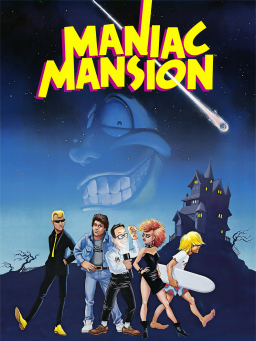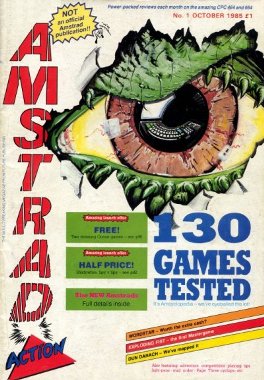
Maniac Mansion is a 1987 graphic adventure video game developed and published by Lucasfilm Games. It follows teenage protagonist Dave Miller as he attempts to rescue his girlfriend Sandy Pantz from a mad scientist, whose mind has been enslaved by a sentient meteor. The player uses a point-and-click interface to guide Dave and two of his six playable friends through the scientist's mansion while solving puzzles and avoiding dangers. Gameplay is non-linear, and the game must be completed in different ways based on the player's choice of characters. Initially released for the Commodore 64 and Apple II, Maniac Mansion was Lucasfilm Games' first self-published product.

Amstrad Action was a monthly magazine, published in the United Kingdom, which catered to owners of home computers from the Amstrad CPC range and later the GX4000 console.

An Easter egg is a message, image, or feature hidden in software, a video game, a film, or another — usually electronic — medium. The term used in this manner was coined around 1979 by Steve Wright, the then-Director of Software Development in the Atari Consumer Division, to describe a hidden message in the Atari video game Adventure, in reference to an Easter egg hunt.

Centipede is a 1981 fixed shooter arcade video game developed and published by Atari, Inc. Designed by Dona Bailey and Ed Logg, it was one of the most commercially successful games from the golden age of arcade video games and one of the first with a significant female player base. The primary objective is to shoot all the segments of a centipede that winds down the playing field. An arcade sequel, Millipede, followed in 1982.

Athena is a 1986 platform arcade video game developed and published by SNK. Conversions were later released for the NES console and ZX Spectrum and Commodore 64 home computers.
Questprobe is a trilogy of graphic adventure video games featuring Marvel Comics characters. The three games are Questprobe featuring The Hulk, Questprobe featuring Spider-Man and Questprobe featuring Human Torch and Thing.
1988 saw many sequels and prequels in video games, such as Dragon Quest III, Super Contra, Super Mario Bros. 2, Mega Man 2, Double Dragon II: The Revenge, and Super Mario Bros. 3, along with new titles such as Assault, Altered Beast, Capcom Bowling, Ninja Gaiden, RoboCop, Winning Run and Chase H.Q.
1987 saw many sequels and prequels in video games, such as Castlevania II: Simon's Quest, Dragon Quest II, Final Lap, and Zelda II, along with new titles such as After Burner, Contra, Double Dragon, Final Fantasy, Mega Man, Metal Gear, Operation Wolf, Phantasy Star, Shinobi, Street Fighter and The Last Ninja. The Legend of Zelda was also introduced outside of Japan.

Shamus is a shooter with light action-adventure game elements written by Cathryn Mataga and published by Synapse Software. The original Atari 8-bit computer version was released on disk and tape in 1982. According to Synapse co-founder Ihor Wolosenko, Shamus made the company famous by giving it a reputation for quality. "Funeral March of a Marionette", the theme song from Alfred Hitchcock Presents, plays on the title screen.

Guerrilla War, released in Japan as Guevara (ゲバラ), is an overhead run and gun video game developed and published by SNK. Originally released in 1987 as a coin-operated arcade game, Guerrilla War was ported to the Amstrad CPC, Apple II, Commodore 64, MS-DOS, Nintendo Entertainment System, PlayStation Network, and ZX Spectrum.

Congorilla, originally a human character known as Congo Bill, is a superhero appearing in comic books published by DC Comics and Vertigo Comics. Originally co-created by writer Whitney Ellsworth and artist George Papp, he was later transformed into Congorilla by Robert Bernstein and Howard Sherman. The character first appeared in More Fun Comics #56.

Moon Cresta is a fixed shooter video game released by Nichibutsu for arcades in 1980. In North America, it was licensed to Sega/Gremlin and Centuri, the latter releasing it in arcades as Eagle. Incentive Software published ports of Moon Cresta for the Amstrad CPC, Commodore 64, Dragon 32 and ZX Spectrum home computers. In 2022, the original arcade version will be included as part of the Sega Astro City Mini V, a vertically-oriented variant of the Sega Astro City mini console.

In video games, first-person is any graphical perspective rendered from the viewpoint of the player character, or from the inside of a device or vehicle controlled by the player character. It is one of two perspectives used in the vast majority of video games, with the other being third-person, the graphical perspective from outside of any character ; some games such as interactive fiction do not belong to either format.

Questprobe featuring The Hulk is a 1984 graphic adventure video game developed and published by Adventure International in collaboration with Marvel Comics. It is the first entry in Questprobe, an intended series of graphic adventure games that only released three installments before the developer's bankruptcy. The game's narrative follows the Marvel superhero Hulk and his human alter-ego Bruce Banner, who must explore the mysterious lair of the Chief Examiner. The graphics and story outline were created by Marvel artists and writers. Critical reception was generally positive, with much of the praise going to the visuals. Reactions to the gameplay were mixed, especially upon the game's budget re-release, by which time it was considered dated.
MS Paint Adventures, abbreviated MSPAdventures or MSPA, was a website and collection of webcomics written and illustrated by Andrew Hussie. According to some estimates, in April 2016 MS Paint Adventures was the largest collection of comics on the Internet, containing over 10,000 pages among its five series.

Breakers is a science fiction-themed interactive fiction video game published in 1986 by Synapse Software, which was then a division of Broderbund. It was released for the Apple II series, Atari ST, Commodore 64, and MS-DOS. The game was the last of Broderbund's "Electronic Novels" series, and was not a commercial success. Critics complimented the complex storyline, but found the game's parser had not kept pace with other game developers.

Planet of Lust is a 1989 erotic text adventure game developed and self-published by Free Spirit Software, and released for Commodore 64, DOS, Atari ST, and Amiga. The Amiga version of Planet of Lust was released in Europe in April 1989. Planet of Lust is the second game in the Brad Stallion series; it is preceded by Sex Vixens from Space (1988), and succeeded by Bride of the Robot (1989) and Sex Olympics (1991).

Echelon is a video game originally published in 1987 by Access Software.














